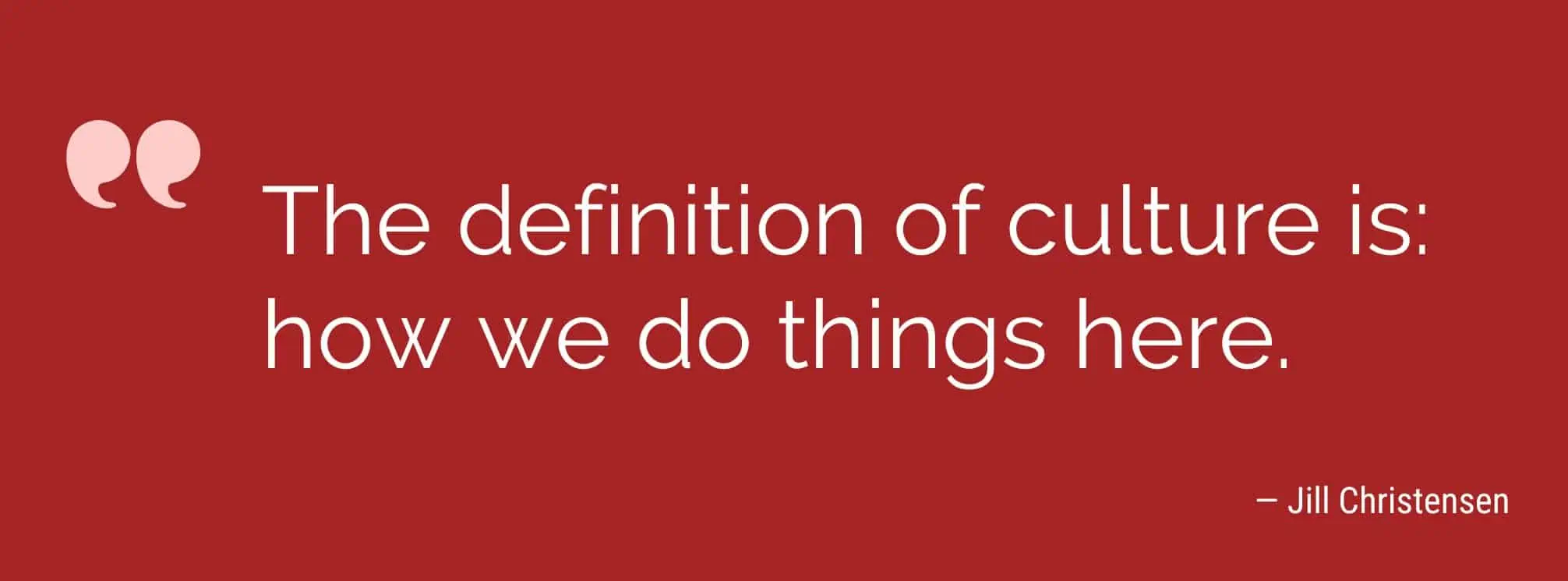
With each passing year, workplace culture and company values are becoming more important. We’re not just talking words on the wall like “Integrity” and “People Matter.” We mean how companies act and treat people. We’re talking about really living your values.
But you can’t just wave a magic wand and have the culture you want. It comes from your employees and how you do business. So, how do you figure out what your culture is really like…and then how do you improve it?
In this blog, we’ll share what workplace culture is and how you can become a more purpose-driven company.
There are a lot of definitions of workplace culture. It’s the shared beliefs, behaviors, and attitudes of the people within a company.
One of our favorite definitions of culture is from Jill Christensen. She says::
“The definition of culture is how we do things here.”
We love this because it boils this huge concept into a really simple idea. Your beliefs and attitudes shape your behavior, right? But this definition focuses on the actual output: how do you actually behave?
A lot of times, companies will define their company culture, but it’s completely aspirational. It’s not at all grounded in how their employees actually feel and act on a daily basis. Company culture isn’t what you’d like to be doing, it’s how you actually behave.

Culture in the workplace is one of the most important things about the employee experience. It has a huge impact on whether or not employees stay with an organization and how dedicated they are.
In the last few Edelman Trust Barometer reports, values have come into the forefront with 86% of employees expecting their CEOs to publicly speak out about social issues and 68% even think that CEOs should personally step in to fix social problems.
Gallup research has also found that “just a 10% improvement in employees’ connection with the mission or purpose of their organization leads to an 8.1% decrease in turnover and a 4.4% increase in profitability.”
The bottom line? Employees want to work for companies that stand for something meaningful. Somewhere they can make an impact. That makes communicating about and reinforcing company values, your mission, and your purpose of paramount importance.
While we all want to have and maintain positive work cultures, it’s not always easy to get there. Because culture is made up of the attitudes and actions of the group, a few bad eggs on a team can really drag your culture down.
Although it’s not easy, you can take steps to develop a more positive work environment. Here are some ways to get started:

Ultimately, you can’t create a strong workplace culture if you don’t have a clearly defined purpose. Your purpose is the north star that employees march towards. This makes it one of the best ways to get everyone committed and rowing in the same direction.
These five steps can help you get started creating a purpose-driven company culture.
Step one might be obvious: you have to actually know what your purpose is. And this purpose has to be meaningful to your teams. It can’t just be “to become more profitable,” right? Your purpose has to motivate and inspire people.
It also has to be unique to your company. Why does your business, specifically, exist? How are you making a difference? Why should employees work for you compared to your competitors?
Answering these questions will help you learn why you exist and help you define your company purpose.
Even if your purpose and values aren’t new to your company, new hires won’t be familiar with them and even existing employees will need refreshers.
Aligning your value communications campaigns with change management best practices is a great recipe for success. Because, remember, asking your people to live your values is a behavior change.
Our favorite change management model is the Prosci ADKAR Method. ADKAR stands for awareness, desire, knowledge, ability, and reinforcement.
KR Wolfe is a masterclass in bringing their values into everything they do. There is no question at this company that the values are more than words on the wall, but why do they do what they do. And it’s because they:
There is no room for doubt at KR Wolfe that the values actually matter to how they conduct business and why they exist as an organization. As a result, they have a great workplace culture and engaged workforce all working towards one common goal.
Employee recognition is important, period. But the more you’re able to root recognition in your values, mission, and purpose the better.
This step is a natural continuation of step two and a great way to embed values in your culture beyond just talking about it. And this is led by your managers. When you instruct your managers to not just “recognize team members regularly” but to “recognize a team member for living one of our core values every week” you start to be onto something.
Not only does this show that you really value the values, but it’s great motivation for behavior change. Regular, positive reinforcement of the values helps employees know exactly what it is that they need to do to succeed and gives them something concrete to work towards.
[optin-monster slug=”rqym9uuuprhbn6tfkund” followrules=”true”]
The Edelman data is clear: all eyes are on the CEO (and senior leadership in general) to lead by example and be the ones leading the charge on change at your company.
So, it’s really time for the C-Suite to step up, get behind the camera, and be more visible to your teams. That’s step one, your employees need to actually know who the CEO is, what they stand for, and see that they care about opening the lines of communication. Step two is to get more vulnerable and take a stand. If one of your values is People Matter, prove it to your employees first. If you do that, your employees will take care of your customers. Plain and simple.
Some great best practices for making CEO communications about the values a habit include:
At the end of the day, it’s your frontline teams who are the face of your company. How they feel about your organization directly impacts how others will perceive your company.
Care for your people and build a great workplace culture—not because it improves the bottom line, which it does—but because it’s the right thing to do for your employees. If you do that, you’re well on your way to being a more value-aligned, effective, and purpose-driven company.
Michael Marino is the Vice President of Marketing where he oversees the creation and execution of theEMPLOYEEapp’s marketing programs. Before joining the team, Mike held marketing leadership positions in both the B2B and DTC spaces in channels that include media, manufacturing, and professional services. Mike is passionate about demand generation, mar-tech, and being able to create campaigns that connect with Internal Comms audiences.
[optin-monster slug=”gqorn0natkqgyrtjvr6i” followrules=”true”]